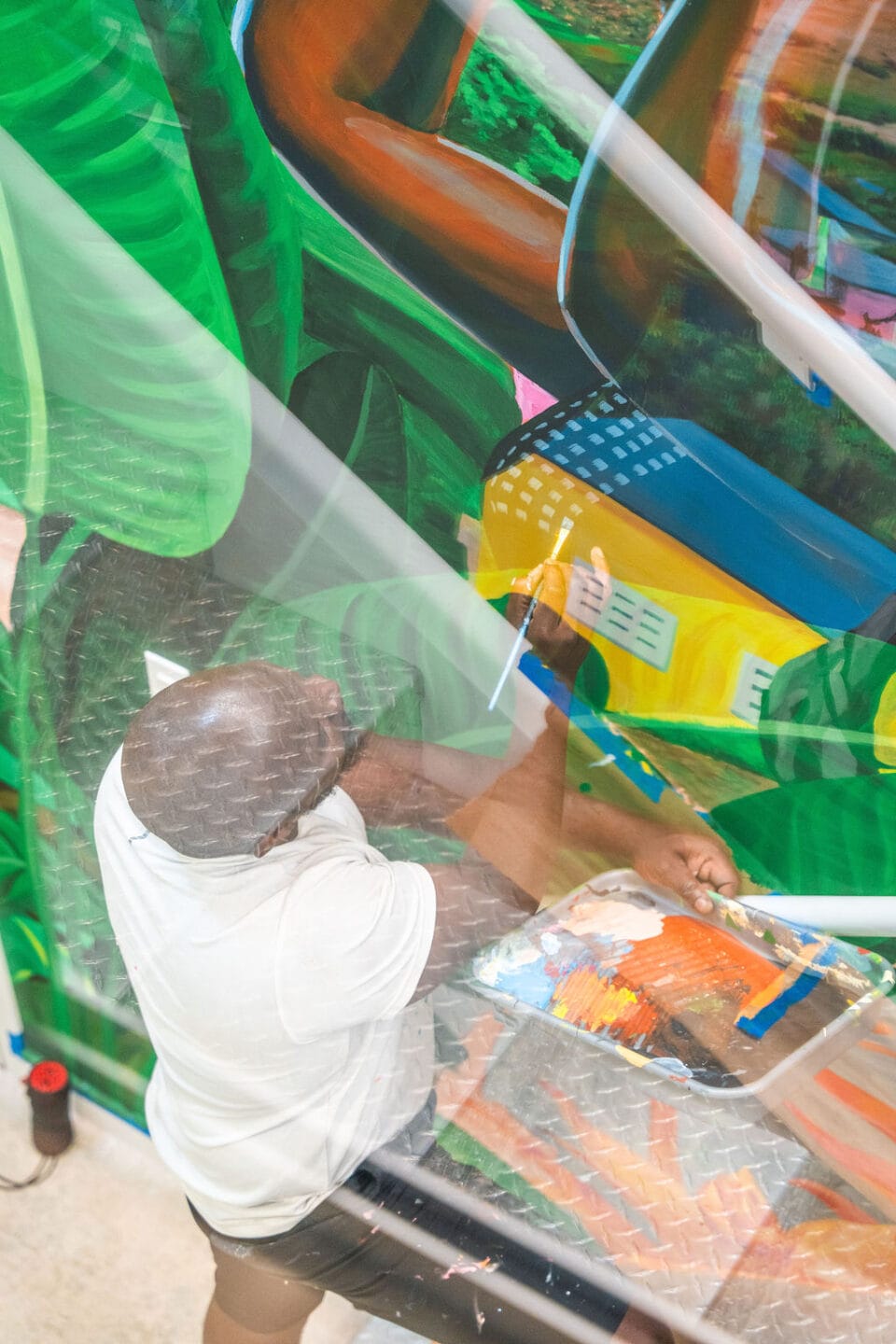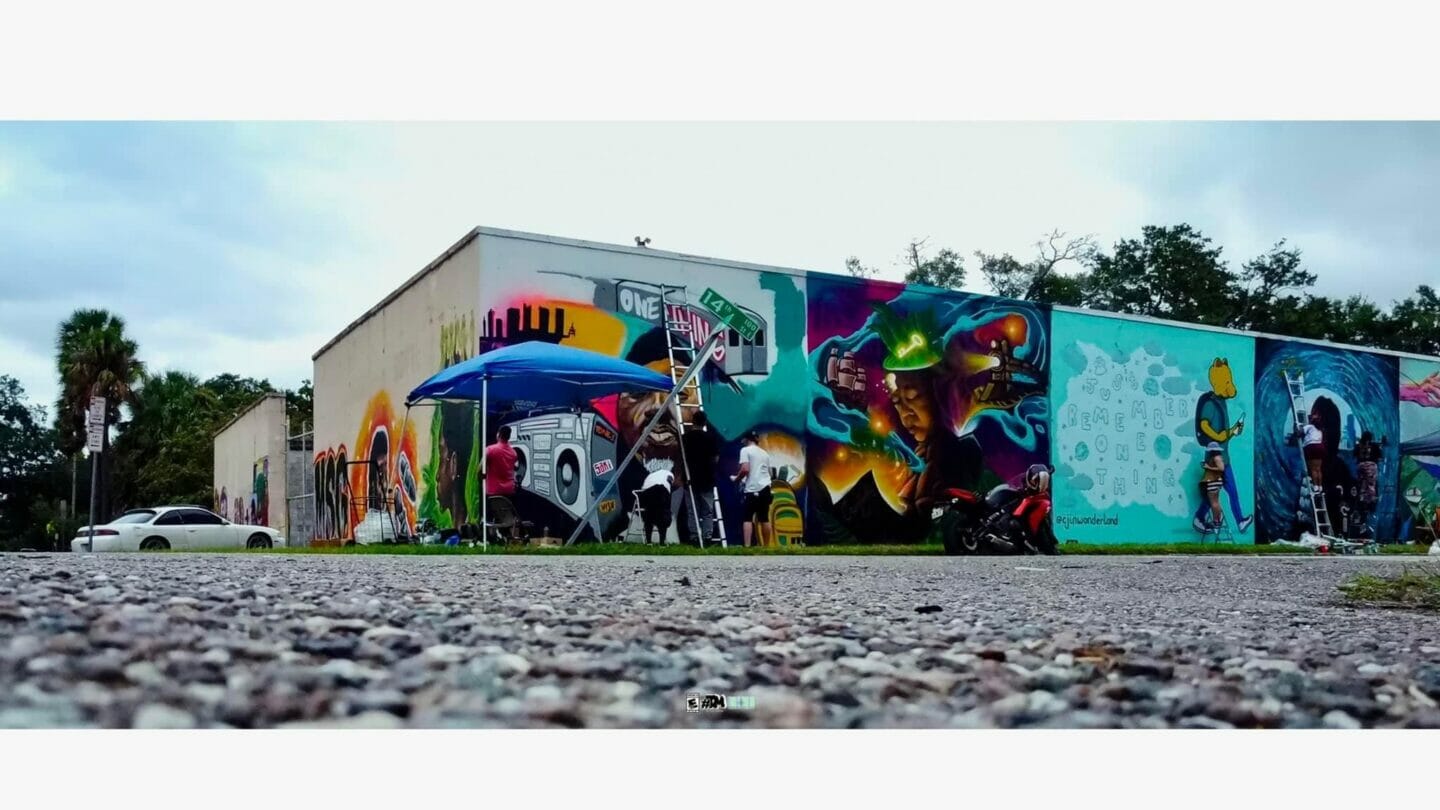James Brutus | Website | Instagram
”Delivrance” ~ Indoor mural for the Climate & Innovation HUB powered by Future of Cities in Ti Ayiti | Little Haiti. Latex Paints on Walls | 20ft by 20ft (Stairway)

“In Haitian society, where formal job opportunities are scarce, women take on the role of primary caregivers and often rely on informal trade as their main source of employment. Referred to as the ‘Poto-mitan’ or ‘backbone’ of their communities, Haitian women bear the weight of family responsibilities, from nurturing children to providing economic support. Many, particularly those without access to education, turn to informal commerce, selling agricultural produce and other essentials. This mural pays tribute to the resilience and strength of Haitian women, depicting a central figure gracefully balancing a basket of fruits on her head, a skill that speaks volumes about her balance and expertise. Set against the backdrop of urban/rural Haiti, the artwork captures the vibrant tapestry of everyday life, steeped in a rich cultural heritage. Women are depicted navigating rugged landscapes with remarkable ease, embodying a spirit of determination as they fulfill their duties. The mural serves as a poignant reminder of an era when manual labor was indispensable for survival, showcasing the tenacity of Haitian women and their families as they traverse tropical terrain, hills and valleys. It stands as a testament to their invaluable contribution to society and their unwavering ability to surmount obstacles with grace and resilience. The title ‘Delivrance’ is in loving memory of my mother, Delivrance Brutus.”
JAMES BRUTUS

Shot by VACO Studio
James Brutus is a Haitian-American artist hailing from the vibrant city of Miami, Florida whose artistic journey has been a lifelong adventure that began during the earliest days of wielding crayons. Learn more about James’ work, mission and inspirations HERE.
by Emily Moody

“As an artist, I’m always looking for ways to create opportunities that include other artists or allow for collaborations, and being familiar with the Phoenix Arts District and the work that they are doing, I realized that they had the perfect space for a project like this.” Jason Tetlak, Jacksonville artist, told our team after the 48 Hour Mural Project was complete at the Phoenix-Jacksonville Arts+ Innovation District (PHX-JAX).
For us at Future of Cities and PHX-JAX, we believe in Regenerative Placemaking as the approach to urban development that fosters more equitable, just, sustainable and resilient communities for a future that celebrates and brings opportunities for health, artistic expression, culture, and education for all.

Our local teams engage regularly with Jacksonville community members and artists to transform our ideas and projects into reality for regenerative placemaking: “I was excited that Emily and the folks over at Phoenix saw the value of bringing the arts community together and jumped on board to and did a lot of work to bring this idea to life.”
At the PHX-JAX Arts + Innovation District, the concept came about to partner with the 48 Hour Film Project but make it mural focused, as opposed to film — and use the same framework of an international film project as a model for visual artists.
The idea came to life over the weekend of September 29 to October 1st, with the first ever 48 Hour Mural Project held at PHX-JAX, in a celebration of art, community, and culture.
This one-of-a-kind event showcased the talents of nine artist teams who embarked on a whirlwind journey to produce stunning murals from inception to completion within the timeframe of 48 hours.
At the 48th hour mark, artists place down their paintbrushes.

Each team of artists brought their own unique perspective and style, showcased in the diversity and rich meaning behind their works, as they embraced this challenge with dedication to their craft. The results were a testament to their passion and skill, as they breathed life into the walls along 14th Street between Market and Hubbard Streets in North Springfield.
The amazingly talented artists teams included Grace Bio, Shea Slemmer & Jimmy Butcher, Jacksonville Arts & Music School (JAMS), Toneism, Zulu Painter, Toi Drayton, Barbara Hionides, Heart, Dosar, and RawSol.

Throughout the 48-hour period, the Phoenix Arts & Innovation District buzzed with excitement as locals and visitors witnessed the murals’, and the street’s, transformation.
Regenerative placemaking came to life as we collectively co-created new vibrancy into the neighborhood.

The event served as a catalyst for community engagement, bringing people together to celebrate creativity, culture, and the unique history of Jacksonville.

“It was a joy to see people coming together,” said Emily Moody PHX-JAX Director of Community Engagement:
“The neighborhood residents and community members at large, driving by, getting out of their cars, walking around and engaging with the artists. It is powerful and inspiring to not only witness muralists in action but also share a conversation with them and hear the story behind their work of art.”

“I loved seeing mural artists working side by side. I know from experience that painting in public is often a solitary job, so providing a festival atmosphere for local artists to have a shared experience where they were able to engage with each other while creating was amazing.” Jason added.

“Seeing the different interpretations and approaches was fascinating. I was surprised to see how nine different artists and teams took the same prompts and came up with so many different designs.”
Prompting artists to add in biophilic nature and elements of Jacksonville history is helping foster cultural identity and a sense of belonging from residents of different backgrounds, while also contributing to a safer, more vibrant neighborhood.

Stay tuned to see the announcement of the winners from this artistic competition — on October 24th during the 48 Hour Film Project Awards at WJCT Studios!

Podcast with Dr. Weiselande “Yanui” Cesar of Tradiyson Lakou Lakay Dance & Alexandra J Tohme, Future of Cities
by Alexandra J Tohme
The water movement of our bodies — as we express it in the dance — is reflective of the water on the journey from homeland to refuge — represents the trauma experienced in that journey — and also, leads us to healing, as water is life.
This is one of the essences of Haitian Folkloric Dance, rooted in the West African traditions from the ancient empires of Dahomey, Oyó, and Kingdom of Kongo (modern day Bénin, Nigeria, Congo and Angola.)
On a Wednesday evening, colleagues at the Future of Cities Climate + Innovation HUB, with Haitian neighbors, women and non-Haitian Miami folks, came together to share this dance form and were encouraged to fully release ourselves in the dramatic movements: from feeding-the-earth hands and sweep-floor arm gestures, to warrior leaps and jumps, to throws of celebration and prayer to the moons. Reverberations boomed through the room with six live conga drummers igniting our movement.
Culture is at the heart of regenerative placemaking — to deeply engage in “place” and co-create experiences and projects that uplift and empower communities, attract impact investment, and regenerate the natural environment.

Dr. Weiselande “Yanui” Cesar, who completed her PhD in human services & public health, explains that Haitian Folkloric Dance first sets itself apart with live drumming, and begins with an understanding within yourself of the struggles that can be released and let go of — and joy takes over.
It is precisely this dance form that Yanui harnessed when deciding to work with children with disabilities, upon founding her non-profit Tradiyson Lakou Lakay, loosely translated into “hometown traditions.” “Sometimes in order to serve those in need” she told us, “ you must tap into your own skill and passion.” That is what she’s done with folkloric dance. To reach and engage these children, and give them expression and outlet from societal barriers, she catalyzed this unique art form that is as much spiritual health as it is mental and physical. This proved to be well received by the children facing the daily issues and stigmatizations from their community — it was the parents who were more resistant at first to accept it. She said that some members of the Haitian community were not too thrilled to see representations of their more traditional culture while trying to assimilate into a new society and modern country. Later, upon seeing their children perform with such joy, their mindset changed.
Unfortunately — these are not feelings unique to Haitian but rather many immigrant societies that feel a pressure to negate their homeland cultures, in order to survive and succeed. But is that true, or necessary?
We at Future of Cities believe in “community ● nature ● culture” as the keys to successful and equitable economic growth and as the vanguard of development. “Regenerative placemaking” involves looking at the vast and wonderful opportunities within local communities, natural ecosystems, and cultural vibrancy that unlock economic empowerment. Tradiyson Lakou Lakay is an excellent example of that — providing jobs to drummers and dancers and integrating into local schools to fill the educational gap for children with special needs. Beyond what is in front of a developer, regenerative placemaking encourages urban practitioners to look for the lesser known or “unseen” treasures; and offering a hand-up, not a hand-out, is exactly what is needed today. All stakeholders would be set to benefit, a win-win-win.
Oba, oba lémiye
Sa nou te pédi a se li nape chéche
Oba, oba lémiye

Back at our dance class event at the Climate + Innovation HUB, some twenty women of various backgrounds, American, Haitian, Latina, Arab, sit in a circle singing those poems and drinking fresh juices catered by the local family Haitian restaurant Cecibon, while a local videographer captures the scene. Circular economy can be achieved in every effort. Each time we put together an event or activity, we make sure to source from small local businesses. From the videographer, photographer, DJ, food caterers, and more, we focus on supporting local economic growth and jobs.
The twenty women sat and sipped juices and repeated those poetic songs together in celebration, laughing and sharing a tradition dating back four centuries.
While embracing heritage, we also recognize the importance of modernity. “Assimilation is critical, without losing our identity” emphasizes Dr. Cesar. It is empowering to learn new languages, technical skills, study in higher education — and connect with people of all backgrounds — that is the magic and beauty of diverse cities. Opportunities can be created for children and youth to thrive by mixing the old and the new. As Future of Cities continues our programs and efforts, it is resilient stories like Yanui’s — of overcoming struggle to celebration — that we will continue to share with the world as we co-create our common future on this planet.




